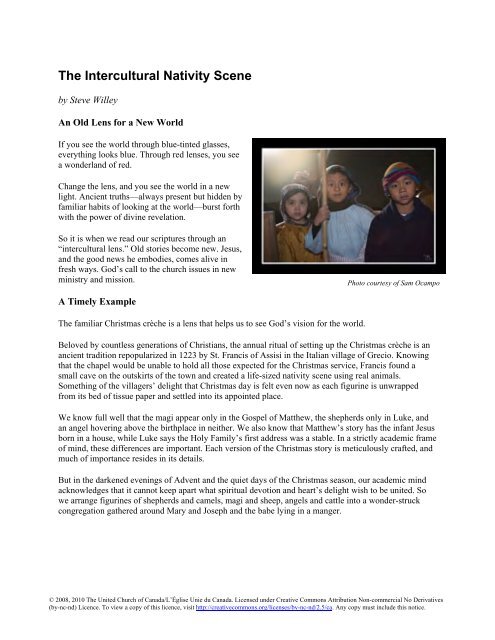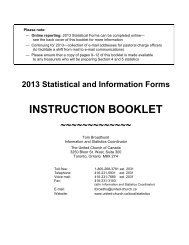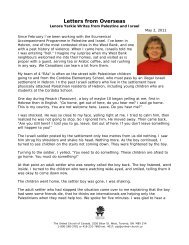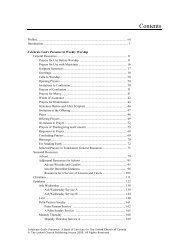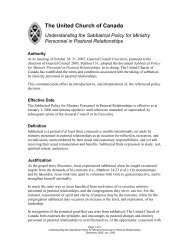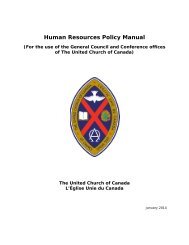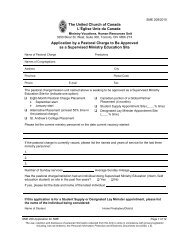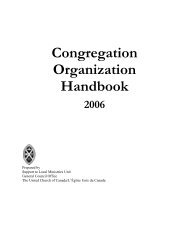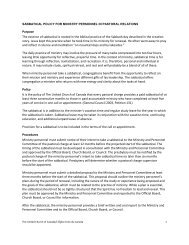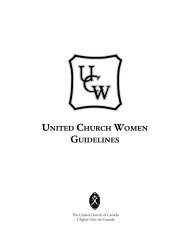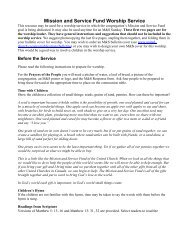The Intercultural Nativity Scene - The United Church of Canada
The Intercultural Nativity Scene - The United Church of Canada
The Intercultural Nativity Scene - The United Church of Canada
Create successful ePaper yourself
Turn your PDF publications into a flip-book with our unique Google optimized e-Paper software.
<strong>The</strong> <strong>Intercultural</strong> <strong>Nativity</strong> <strong>Scene</strong><br />
by Steve Willey<br />
An Old Lens for a New World<br />
If you see the world through blue-tinted glasses,<br />
everything looks blue. Through red lenses, you see<br />
a wonderland <strong>of</strong> red.<br />
Change the lens, and you see the world in a new<br />
light. Ancient truths—always present but hidden by<br />
familiar habits <strong>of</strong> looking at the world—burst forth<br />
with the power <strong>of</strong> divine revelation.<br />
So it is when we read our scriptures through an<br />
“intercultural lens.” Old stories become new. Jesus,<br />
and the good news he embodies, comes alive in<br />
fresh ways. God’s call to the church issues in new<br />
ministry and mission.<br />
Photo courtesy <strong>of</strong> Sam Ocampo<br />
A Timely Example<br />
<strong>The</strong> familiar Christmas crèche is a lens that helps us to see God’s vision for the world.<br />
Beloved by countless generations <strong>of</strong> Christians, the annual ritual <strong>of</strong> setting up the Christmas crèche is an<br />
ancient tradition repopularized in 1223 by St. Francis <strong>of</strong> Assisi in the Italian village <strong>of</strong> Grecio. Knowing<br />
that the chapel would be unable to hold all those expected for the Christmas service, Francis found a<br />
small cave on the outskirts <strong>of</strong> the town and created a life-sized nativity scene using real animals.<br />
Something <strong>of</strong> the villagers’ delight that Christmas day is felt even now as each figurine is unwrapped<br />
from its bed <strong>of</strong> tissue paper and settled into its appointed place.<br />
We know full well that the magi appear only in the Gospel <strong>of</strong> Matthew, the shepherds only in Luke, and<br />
an angel hovering above the birthplace in neither. We also know that Matthew’s story has the infant Jesus<br />
born in a house, while Luke says the Holy Family’s first address was a stable. In a strictly academic frame<br />
<strong>of</strong> mind, these differences are important. Each version <strong>of</strong> the Christmas story is meticulously crafted, and<br />
much <strong>of</strong> importance resides in its details.<br />
But in the darkened evenings <strong>of</strong> Advent and the quiet days <strong>of</strong> the Christmas season, our academic mind<br />
acknowledges that it cannot keep apart what spiritual devotion and heart’s delight wish to be united. So<br />
we arrange figurines <strong>of</strong> shepherds and camels, magi and sheep, angels and cattle into a wonder-struck<br />
congregation gathered around Mary and Joseph and the babe lying in a manger.<br />
© 2008, 2010 <strong>The</strong> <strong>United</strong> <strong>Church</strong> <strong>of</strong> <strong>Canada</strong>/L’Église Unie du <strong>Canada</strong>. Licensed under Creative Commons Attribution Non-commercial No Derivatives<br />
(by-nc-nd) Licence. To view a copy <strong>of</strong> this licence, visit http://creativecommons.org/licenses/by-nc-nd/2.5/ca. Any copy must include this notice.
<strong>The</strong> <strong>Intercultural</strong> <strong>Nativity</strong> <strong>Scene</strong><br />
Pilgrims and Border-Crossers<br />
It is fitting that, to create a manger scene, we must transport figures across the boundaries separating one<br />
New Testament gospel from another. After all, as both Luke and Matthew attest, all the creatures gathered<br />
around the Christ child have crossed over significant borders. Some <strong>of</strong> those borders are geographical;<br />
some are cultural.<br />
1. Mary, Joseph, and their donkey cross over from Galilee into Samaria, and from there into Judea.<br />
2. <strong>The</strong> noble Magi and their camels make a lengthy western journey through many lands into the<br />
midst <strong>of</strong> an unfamiliar people.<br />
3. <strong>The</strong> rough shepherds, with a lamb or two, leave behind the rural hillsides for the groomed streets<br />
<strong>of</strong> Bethlehem.<br />
4. <strong>The</strong> holy angels traverse the celestial boundary separating heaven and earth.<br />
Why have they left their familiar homes and risked the journey to a destination <strong>of</strong> manure and mystery?<br />
To greet Jesus upon his arrival at the end <strong>of</strong> one journey and the beginning <strong>of</strong> another.<br />
To bear witness as he crosses the boundary from being a human fetus to being a baby, and from being the<br />
disembodied divine Word, to being Emmanuel, which means “God with us” (John 1:1-5).<br />
An <strong>Intercultural</strong> Circle<br />
<strong>The</strong> stable space God creates for the Christ child is radically diverse space, and the human community<br />
God chooses to welcome and embrace the Truly Human One is an intercultural community. Jesus is the<br />
centre <strong>of</strong> this diverse circle. This is why we turn all the figurines <strong>of</strong> our crèche so they face the babe lying<br />
in the hay. Everyone is attentive to him. Eyes are focused on him and ears are attuned to his cry.<br />
As the glow that warms and enlightens, Emmanuel unites the diverse community <strong>of</strong> worshippers not<br />
through a forced uniformity but through the gift <strong>of</strong> new, deep relationship.<br />
<strong>The</strong> Bethlehem scene that we freeze in our crèches for a few weeks <strong>of</strong> wonder actually exists for only a<br />
moment in the biblical narrative. It’s a transforming vision to behold, however, and one that is fully<br />
integrated into the larger biblical Story <strong>of</strong> God’s redeeming and liberating love.<br />
Between the Alpha and the Omega<br />
Hearkening to the beginning <strong>of</strong> days, the nativity tableau evokes Eden before the Fall. Bethlehem<br />
witnesses a moment <strong>of</strong> paradise regained where all God’s creatures dwell in harmony: the four-legged,<br />
the two-legged, those with wings both angelic and avian. <strong>The</strong> three rich magi and the poor shepherds<br />
kneel side by side in a startling truce between wolves and lambs. Together they cradle the vulnerable<br />
Christ child with their devotion.<br />
Those among them who in other times have been comfortable in the courts <strong>of</strong> tyrants make a pact to<br />
disobey the snake, Herod, who will soon appear on the scene hissing lies and making smooth the way for<br />
death. In this moment <strong>of</strong> nativity, Emmanuel is sovereign. God is with us, and we are drawn home to<br />
Eden.<br />
<strong>The</strong> <strong>United</strong> <strong>Church</strong> <strong>of</strong> <strong>Canada</strong> 2 L’Église Unie du <strong>Canada</strong>
<strong>The</strong> <strong>Intercultural</strong> <strong>Nativity</strong> <strong>Scene</strong><br />
<strong>The</strong> nativity tableau also hearkens forward to the end <strong>of</strong> days. As evoked in the Revelation to John, the<br />
Day <strong>of</strong> Consummation will be a day when the slithering beasts <strong>of</strong> death will be conquered by God’s<br />
irresistible desire to create a new heaven and a new earth. <strong>The</strong> universe itself will be a manger:<br />
See, the home <strong>of</strong> God is among mortals. [God] will dwell with them; and they will be<br />
[God’s] peoples, and God…will be with them. Rev. 21: 3<br />
Just as Mary and Joseph came from the hinterland <strong>of</strong> Nazareth, and the shepherds came down from<br />
hidden valleys and hills, and the kings came from far away lands, the New Day <strong>of</strong> John’s dreaming<br />
describes<br />
a great multitude that no one could count, from every nation, from all tribes and peoples<br />
and languages, standing before the throne and before the Lamb...saying, ‘Salvation<br />
belongs to our God!’ Rev. 7:9-10<br />
As the angels came from heaven to rejoice at the coming <strong>of</strong> Emmanuel, so in John’s vision, “all the<br />
angels stood around the throne and…fell on their faces and worshipped God, singing, ‘Amen!’”<br />
(Rev. 7:11-12) <strong>The</strong> lowing <strong>of</strong> cattle once greeted the Christ child, and now we witness,<br />
every creature in heaven and on earth and under the earth and in the sea,<br />
and all that is in them, singing,<br />
‘To the one seated on the throne and to the Lamb<br />
be blessing and honour and glory and might<br />
forever and ever!’ Rev. 5:13<br />
Back to the Future<br />
Is the allure <strong>of</strong> the Christmas crèche exerts any wonder? It expresses not only our deepest yearning for<br />
God, but our most pr<strong>of</strong>ound hope for a world at rest where there is peace between its diverse peoples, and<br />
harmony among the species.<br />
Through an intercultural lens we see afresh God’s originating vision. Our vocation as the church born <strong>of</strong><br />
that vision, is to embody it and, thereby, bear faithful witness to God made known in Bethlehem, Eden,<br />
and the New Jerusalem.<br />
<strong>The</strong> <strong>United</strong> <strong>Church</strong> <strong>of</strong> <strong>Canada</strong> 3 L’Église Unie du <strong>Canada</strong>


